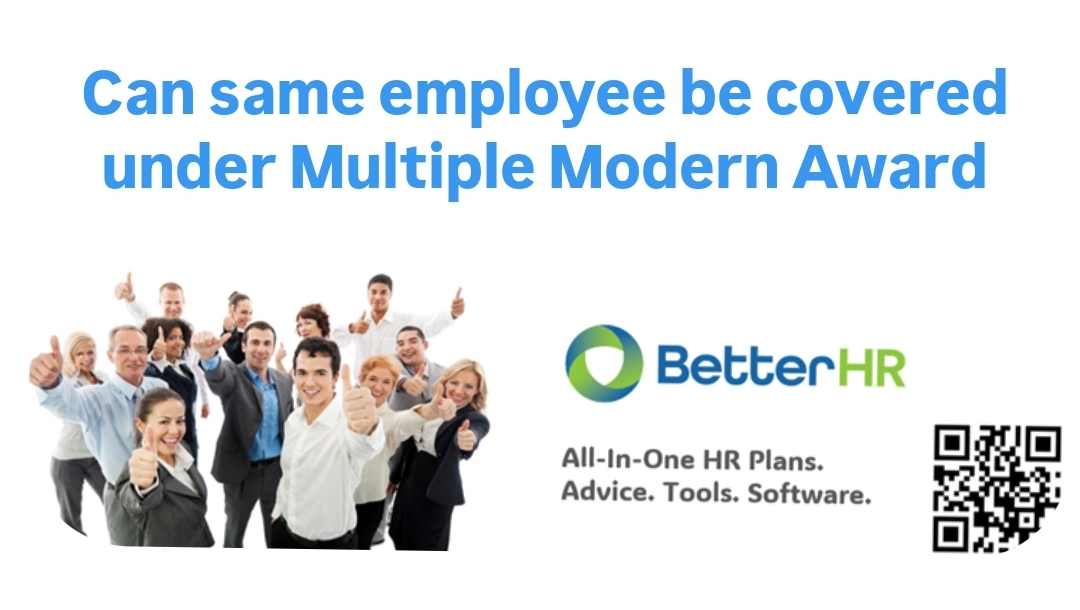The minimum pay rates and working conditions for the employees are regulated through industrial instruments such as Modern Awards, Enterprise Agreements or the National Employment Standards (NES) under the Fair Work Act 2009.
Employee are covered by the award that applies to the primary duties of their role, with any ancillary duties falling under the same award. Most awards/agreements provide for higher duty allowances which is paid when employees perform duties that are above their classification and have no change in pay for duties that fall in lower classifications.
However, a question that frequently arises is whether an employee, who performs two or more different sets of duties with same employer, can be covered under two separate sets of industrial instruments, such as two different Modern Awards or the NES (for Award/Agreement free) and a Modern Award?
The short answer is that where an employee performs work under two or more roles i.e has two or more jobs with the same employer, they may be covered by more than one industrial instrument such as two Modern Awards for example. Here are three key points to consider when determining that an employee whether an employee’s duties fall under one role or multiple roles:
1. The Primary Function of each Role
The primary test for determining which industrial instrument applies is the nature of the employee’s role and duties performed. If an employee performs a mixture of tasks that are ancillary to one role, only one industrial instrument (modern award) will apply. However, if they perform tasks that are different in nature (i.e are for different roles), which have different job descriptions and there is no classification for either role in the same award, it is likely that the employee will be covered under two or more industrial instruments and the employee’s primary duties under each role will be key in deciding which award applies for each role.
Below are some examples to illustrate this.
Example 1: An employee who works primarily as a registered nurse at a medical practice but occasionally performs administrative duties such as data entry or medical billing relating to the clients, she/he attends may still be covered by the Nurses Award for most of their work, as the administrative tasks are considered supplementary or ancillary to their primary nursing duties.
Example 2: An employee working as both a nurse and a cleaner at a medical practice will most likely be covered by different awards for each of their roles if these duties are distinct and require separate job descriptions.
2. Separate Employment Contracts for Each Role
If the roles are sufficiently distinct to warrant separate coverage by different industrial instruments, the employee would generally need to have separate employment contracts for each role. This means that employer should provide different rosters and payslips for each role, and clear job descriptions for each role that outline the specific duties and expectations. In such circumstances, the employee would accrue leave separately for each role.
Having these clearly stated separate arrangements ensure that the employer and employee are aware of which role is being performing at any given time. These arrangements also allow for the employee to be compensated according to the respective industrial instrument for each specific job.
3. Are the Roles Ancillary or Completely Separate?
If the duties performed by the employee are considered ancillary to one another in a specific role/job, it is unlikely that the employee would fall under multiple awards or be able to establish that the employment relationship for the roles as separate.
For example, a nurse who spends a small portion of their time doing ancillary administrative work like managing patient records, perform reception covers or assisting with stock take will likely remain under the Nurses Award 2020 because these tasks are secondary to their nursing responsibilities.
However, if the nurse has an entire shift where they only performs under an administrative clerks role for the business that is separate to their ancillary administrative tasks, i.e the administrative clerk role is distinct and involves entirely separate job functions including different skill sets, qualifications and job description, she may be covered by the Clerks private Sector Award 2020 when performing the Administrative clerks role.
When Can an Employee Work Under Two Different Modern Awards?
There are specific circumstances where an employee can be employed under two or more separate industrial instruments such as two modern awards. This typically arises where the roles, i.e the duties performed under each role, are genuinely different, and there is “clear separation” between roles.
To establish this clear separation, employers should consider the following:
- Assign different hours or shifts for each role
Have a clear distinction between the hours worked under each role. For example:
6am – 3pm, Mondays – Wednesday: Part-time Aged Care Nurse
9am – 5pm, Thursday – Sunday: Casual Administrative Assistant
In the example above when the employee works as a nurse they will be covered under the Nurses Award 2020 whilst when they work as an administrative Assistant they will be covered by the Clerks– Private Sector Award 2020.
- Apply Different Employment Arrangements for each role
Engaging an employee under different employment statuses, i.e full-time, Part-time and/or Casual, for each role will assist in reinforcing that they are separate types of roles and thus covered under separate modern awards.
Going with our Nursing and Administrative Assistant roles example, the nursing role can be offered as part time, whilst the administrative assistant role can be a casual role or vice versa.
3. Address and Maintain Health and Safety
To demonstrate that roles are separate, i.e different in nature (and thus covered by separate modern awards), employers should address any workplace health and safety implications attached when employees work two or more jobs. This is especially prevalent where one of the roles is completed as a full-time position and/or where it the roles include working long hours and/or overtime.
Working extended or long hours can have significant effects on an employee’s health and can cause fatigue and health issues. Fatigue can impact an employee’s ability to perform their job safely and effectively, leading to an increased risk of errors or accidents.
If a decision is made to allow an employee to work multiple roles (two jobs or more) within the organisation, it is crucial for employers to manage for each role the hours of work and overtime and ensure that employees are not working excessively long shifts or being overburdened by the multiple roles that can lead to fatigue.
Employers will be able to demonstrate a clear distinction between two or more roles that an employee does if they fulfil their obligations under each role to:
– monitor’s employees work hours to avoid excessive fatigue.
– provide adequate breaks and recovery time between shifts/workdays.
– ensure employees have access to support and resources to manage stress and fatigue.
Safe Work Australia provides detailed guidelines on the health and safety implications of working long hours and how to manage fatigue in the workplace available at the Safe Work Australia website.
4. Ensure Legal Compliance
Employers can show a separation of roles for an employee with two or more jobs within the company by demonstrating that they complied with all relevant terms and conditions under the applicable industrial instruments (modern awards).
This includes having appropriate records of paying the correct minimum wage, leave entitlements, and other benefits that apply to each role in accordance with their respective industrial instrument (modern award). Employers should also be careful not to use (or rather abuse) applying multiple awards to avoid paying entitlements like overtime or penalty rates.
Additionally, employees should be provided with clear and accurate information about which award applies to each job roles, and how their pay and conditions are structured through separate employment contracts.
Summary
Employees are expected to perform duties additional to their primary role without it affecting the applicable modern award and are paid according to the terms under their contract. The only time an employee will be covered by more than one award, is when their roles are genuinely separate and distinct.
If you are an employer or employee in this situation, it is essential to carefully assess the nature of the roles and seek professional advice if necessary. Employers should ensure that contracts are clearly defined and that all entitlements are paid correctly to avoid any potential legal issues.
If you need further information or assistance, please contact BetterHR’s experienced HR consultants, and qualified lawyers on 1300 659 563 or visit: Subscribe to BetterHR.

















